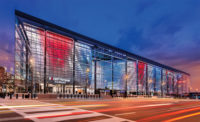In South London, Witherford Watson Mann Offers a Clever Take on the Almshouse Typology

Witherford Watson Mann (WWM) won the Stirling Prize in 2013, with a building that reoccupied the ruin of Astley Castle in rural Warwickshire, England. The historical context of that particular project was material but with the firm’s latest work in the dense urban district of Bermondsey, in south London, the condition to which the building responds is as much the peculiarly British typology of the almshouse as it is the immediate vicinity. Although there are a handful of examples in other countries, almshouses in the United Kingdom have a long social history and are an instantly recognizable architectural form, established in the medieval era but still present in recent times. Funded by charitable foundations, often religious, the buildings are small, single-story attached houses—garden apartments, really—for poor or disabled residents. The almshouse wraps in a U-shape around a courtyard but is open to the street.
United St Saviour's Charity, the client for WWM’s Appleby Blue Almshouse, has been in operation since it was granted funds following the dissolution of the monasteries in the 16th century. To fund a new affordable housing complex for seniors in Bermondsey, the charity looked to a more contemporary source: financial exaction by the local authority for a development elsewhere in the borough. As there was a need for a larger than the number of rooms, the traditional form of the almshouse, even when increased in height to two stories, was not viable. WWM therefore, approached the typology in a conceptual way.

1

2
Facing Southwark Park Road, the 57-unit complex enages with the busy streetscape (1); resident amenities include a central social space with soaring ceilings and oak cladding that bring light and warmth to the space (2). Photos © Philip Vile
The architects devised a two-story almshouse and faced it toward the street. Then they stacked a like structure on top of it, facing the rear. The resulting building ranges in height from five-stories at the front (it is topped with a zinc-clad attic pavilion) to two at the back addressing the lower terraced housing to the rear. A courtyard—the so-called Garden Court—sits in the center. Placed around it are 57 one- and two-bedroom apartments—each including a kitchen, bathroom, and living area—ranging in size from 590 square feet to 850 square feet. Every unit has a view to the exterior and, across a wide gallery with space for seating, into the glazed-off central courtyard.

3

4
The apartments encircle a large central courtyard (3) with views out from a shared residential hallways (4). Photos © Philip Vile
From the exterior, the building doesn’t resemble a typical almshouse. Indeed the clients requested “a Bermondsey building.” The brickwork colors range from blue to brown and the finishes, from reflective to matte, that together complement the hues of the dirty London brick from which the Georgian terraces that adjoin the complex to the rear are built. This potentially dark and brooding presence is mediated on the street facade by several features: the attic pavilion; a two-story, oak-framed loggia, and large windows, also framed in oak, which are recessed into the brickwork. There is also a slight inflection to the facade. It is convex where the road line is concave: a clever, subtle recollection of the wings of the traditional almshouse and a way for the building to open its arms to visitors.

The double-height "living room" at the front of the building. Photo © Philip Vile
There is a very deliberate contrast between the robust exterior and the interior. Behind the glazed loggia is a double-height social space, with ceiling and walls clad in oak. Along the front of the building to the east are kitchens originally intended to be for a café. The client, however, decided to use them for a culinary school that will be open to the public. A larger social space, or garden room, to the west is intended for residents of Appleby Blue Almshouse but also serves as entry point for the community. It opens out onto a delightful courtyard to the south that has been landscaped with trees, raised garden beds, and a long fountain that fills the space with the sound of water.
Inside, as much as outside, WWM has cleverly made this new almshouse a “Bermondsey building.” Around the Garden Court, 130 feet long but just 26 feet wide at its narrowest, external galleries give access to individual residential units in the same way that the traditional “coaching” inns along nearby Borough High Street did. (Only one of them, The George Inn, remains.) What transcends this rather literal transcription of an almost dead building typology is the landscaping, which is redolent of Japanese ryokan, elevating this shared space into something magical, both familiar and transformational.

5

6

7
Appleby Blue residents enjoy shared lounges and social spaces (5), a rooftop garden with planting beds (6), and a central courtyard with a linear water feature (7) that adds tranquility to the space. Photos © Philipp Ebeling (5), Philip Vile (6,7)
It is an important counterpoint to the historical literacy of the project. WWMs approach is not simply a case of aesthetic preferences or bland contextualization but an attempt to provide humane scale and care in an urban environment: a rethinking of how a city might work through more than dogmatic historicism. For too long, social care for the elderly has been pushed to the suburbs. The Appleby Blue Almshouse, for all its typological references, is a beautiful, contemporary pushback against that drift.






